Invicta Seconds Hand Mystery Explained
Invicta Seconds Hand Mystery Explained
by
Rob Berkavicius (Rob B) and Paul Delury (Gumby)
Following the ongoing discussion about the so-called "problem" with the apparent hesitation or pausing of the second hand on some models of Invicta watches, Paul and myself have decided to find out what is really happening here, using one of Paul's Invictas which exhibits this characteristic, as the test subject.
Of concern to some Invicta owners was the observation that, if the watch was tapped on the side, the second hand would sometimes pause, then begin moving again. Was this affecting timekeeping accuracy? Was this an indication of a poor quality movement? Before we can answer these questions, we need to have a close look at the movement in question:
 |
An Invicta Model 8926 Sub lookalike, all stainless steel, and containing a Miyota cal 8215 Auto movement. The 21 Jewel movement features uni-directional winding, has a day/date calendar, and beats at 21,600 bph. The day function is present but not used in this model Invicta. |
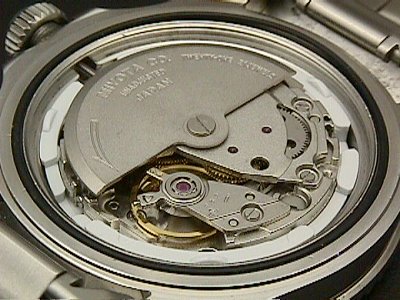 |
A view of the watch with the back removed, showing the very substantial stainless steel case, "O" ring back seal and plastic movement spacer ring. Although some criticism has been levelled at the finish quality, once one gets past the visible surfaces it is certainly not much different from a regular production ETA movement (perhaps the screw heads are not as well finished). Add to that, it is fully jewelled in all the places that really need it, including the automatic winding train. All pivots and wearing surfaces are adequately lubricated, and would not require any attention for some considerable time. |
 |
The Miyota cal 8215 is an indirect sweep seconds design, very common in Swiss watches of even very high grades in the past. It allows for an elegantly simple design of the the watch, in this case the top plate encompasses both the time and winding trains. This view of the train, shows the sweep second pinion which passes through the center wheel, and is driven by the 3rd wheel. |
 |
This view of the underside of the top plate shows the sweep second pinion brake spring, which serves 2 functions. It provides a small amount of friction to the sweep second pinion to stop jitter, and presses the pinion down onto the center wheel jewel, holding it in place and taking up any up-down shake. Also, the very substantial bearing for the auto winding weight can be seen, and incidentally, this contains 14 balls. |
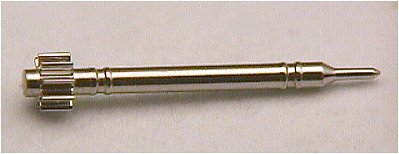 |
A close up view of the sweep second pinion. The flat end on which the brake spring presses can be seen, and 2 sets of rings can be seen on the main part of the shaft, each ring separated by a groove, which is for oil-retention. These rings are the bearing surfaces for the pinion. |
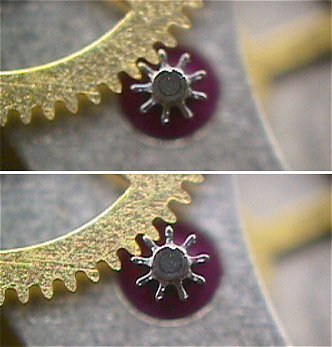 |
Now we are getting close to finding a reason for the pausing second hand phenomenon! The two pics here show the amount of backlash present between the sweep pinion and the 3rd wheel driving it. The brake spring, while effective at removing jitter, does not provide enough tension to hold the pinion steady under all conditions. So, when the watch is knocked, the pinion may be moved partially or all the way to the other side of the "slop", and it may take a second or so for the movement to "catch up" again. Although this looks cosmetically unappealling, it makes no difference at all to the timekeeping of the watch. Increasing the tension of the brake spring must be done with great care, as too much tension will start to significantly affect the balance amplitude (from the extra friction in the train), and thus the timekeeping. And, this indeed is one of the reasons why "direct seconds" watch designs are now favored by watch manufacturers. For more information on the difference between Direct and Indirect Second watch designs, I recommend you read Walt Odet's Horologium article The Pursuit of Center Seconds. |
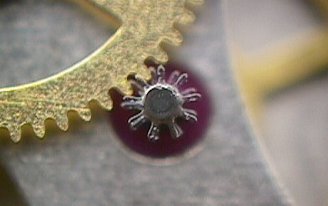 |
To see the backlash more clearly, the two pics above have been overlayed. The maximum amount of play equates to a bit less than 2 seconds on the dial. Why so much backlash? All gear teeth must follow certain engineering design principles to function correctly and not wear out quickly. In watches, the pinion leaves are of a hypocycloidal tooth form and the wheel teeth epicycloidal. While a perfect meshing of gears is theoretically possible, practical manufacturing tolerances dictate otherwise, as any tight spots in this part of the train would cause major problems to the performance of the movement. |
 |
Lest you think the above is an indication of a poor quality movement, here is an Omega cal. 1001 which is also an indirect second design. In this movement, the brake spring presses on a collar on the sweep second shaft, under the pinion. The amount of backlash in this movement is about the same as the Miyota, and the effect of knocking the watch the same. |
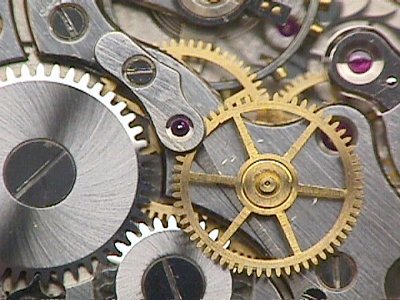 |
An earlier form of indirect seconds can be seen on many different makes and calibres of watch movement. This one, a Peseux 180, is typical of how it was done. The sweep second pinion is driven by a sweep second driving wheel, which is mounted on the outside of the top plate on an extension of the 3rd wheel. The brake spring can be seen passing under the sweep second driving wheel, and it presses the sweep pinion onto the jewel in the outer pinion cock. |
Summary
The "Hesitating Second Hand", observed on Invicta and other brands of watches is simply a characteristic of the "Indirect Seconds" type of movement design and in no way has any effect on the watch accuracy or timekeeping. If any watch company wanted to do something about it, the simplest, and really the only practical solution, would be to poise the second-hand. However, tens of millions of Indirect Seconds type watches of many different manufacture, in all grades from the cheapest pin pallet to high grade Swiss watches have been made in the past 50 years or so, and have been used with no problems at all. Indeed, it is hard to imagine how this characteristic could ever be observed during normal wear on the wrist, anyway. One can only assume it was claimed as a problem in an attempt to find fault in a watch which offers such excellent value for money as the Invictas do. So all you owners of Invictas, Omegas or any of the many, many other brands that use the same method for driving the second hand, there's no need to worry about it!
Text copyright © 2000 by Rob Berkavicius (Rob B)
Images copyright © 2000 by Paul Delury (Gumby) using a Sony Mavica
October 13th 2000, Perth, Western Australia. (Updated October 30th 2000)








